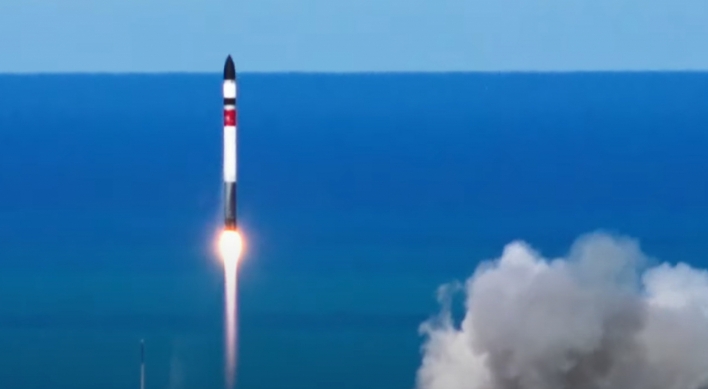PASADENA, California (AP) -- As planet Earth rang in the new year, a different kind of countdown was happening at the moon.
After a 3{-month journey, a NASA spacecraft flew over the moon's south pole, fired its engine and dropped into orbit Saturday in the first of two back-to-back arrivals over the New Year's weekend.

Mission control at the NASA Jet Propulsion Laboratory erupted in cheers and applause after receiving confirmation that the probe was healthy and circling the moon. An engineer was seen on closed-circuit television blowing a noisemaker to herald the New Year's Eve arrival.
``Everything went just as we hoped. The burn was spot-on,'' chief scientist Maria Zuber of the Massachusetts Institute of Technology said in a post-mission interview with The Associated Press.
The team toasted sparkling cider, but the celebration was brief. Despite the successful maneuver, the work was not over. Its twin still had to enter lunar orbit on New Year's Day.
The Grail probes _ short for Gravity Recovery and Interior Laboratory _ have been cruising independently toward their destination since launching in September aboard the same rocket on a mission to measure lunar gravity.
Hours before revelers in Times Square celebrated the New Year, Grail-A approached the moon and fired its engine for about 40 minutes to get captured into orbit. Deep space antennas in the California desert and Madrid tracked every move and fed real-time updates to ground controllers
About 270 family members and friends of the mission team descended on the NASA campus to watch the drama unfold on a live feed.
``This is great, a big relief,'' deputy project scientist Sami Asmar told the jubilant crowd.
Grail is the 110th mission to target the moon since the dawn of the Space Age including the six Apollo moon landings that put 12 astronauts on the surface. Despite the attention the moon has received, scientists don't know everything about Earth's nearest neighbor.
Why the moon is ever so slightly lopsided with the far side more mountainous than the side that always faces Earth remains a mystery. A theory put forth earlier this year suggested that Earth once had two moons that collided early in the solar system's history, producing the hummocky region.
Grail is expected to help researchers better understand why the moon is asymmetrical and how it formed by mapping the uneven lunar gravity field that will indicate what's below the surface.
Previous lunar missions have attempted to study the moon's gravity _ which is about one-sixth Earth's pull _ with mixed results. Grail is the first mission devoted to this goal.
Once in orbit, the near-identical spacecraft will spend the next two months refining their positions until they are just 34 miles above the surface and flying in formation. Data collection will begin in March.
The $496 million mission will be closely watched by schoolchildren. An effort by Sally Ride, the first American woman in space, will allow middle school students to use cameras aboard the probes to zoom in and pick out their favorite lunar spots to photograph.
Despite the latest focus on the moon, NASA won't be sending astronauts back anytime soon. The Obama administration last year nixed a lunar return in favor of landing humans on an asteroid and eventually Mars.
A jaunt to the moon is usually speedy. It took the Apollo astronauts three days to zip there aboard the powerful Saturn V rocket. Since NASA wanted to economize by launching on a small rocket, it took Grail a leisurely 3 1/2 months to make a roundabout trip.
NASA's last moonshot occurred in 2009 with the launch of a pair of spacecraft _ one that circled the moon and another that deliberately crashed into the surface and uncovered frozen water in one of the permanently shadowed lunar craters.
<한글기사>
美, 달 탐사위성 궤도 진입 성공
지난 9월 발사된 미항공우주국(NASA)의 달 중력장 탐사위성 GRAIL-1호가 지난해 31일 오후(현지시간. 한국시간 1일 오전 7시41분) 달 궤도에 성공적으로 진입했다.
NASA 제트추진연구소는 새해 첫날을 목전에 둔 이날 GRAIL-1호가 달의 남극 상 공을 비행하면서 궤도 진입에 성공했다고 밝혔다.
지상 관제소의 NASA 과학자들과 기술진은 GRAIL-1호가 양호한 상태로 달 궤도를 돌고 있다는 신호를 보내오자 손뼉을 치며 환호했다.
이 위성은 달 궤도를 돌며 고르지 못한 달 중력장의 관련자료를 지구에 송신, N ASA 연구진에 달의 비대칭 구조 및 탄생의 비밀 등에 대한 단서를 제공할 예정이다.
제트추진연구소는 총 4억9천600만달러 규모의 이번 탐사선 연구를 통해 달의 중 력장을 탐사해 달 내부에 무엇이 있는지도 아울러 밝힐 예정이다.
GRAIL-1호는 지난 9월 플로리다의 케이프 커내버럴에서 쌍둥이 탐사위성 GRAIL- 2호와 함께 발사됐다.
세탁기 크기의 이 위성은 궤도에 진입한 뒤 200㎞ 간격을 유지한 채 고도 55㎞의 궤도를 돌면서 달 중력장 지도 작성에 필요한 자료를 수집하게 된다.


![[Exclusive] Korean military set to ban iPhones over 'security' concerns](http://res.heraldm.com/phpwas/restmb_idxmake.php?idx=644&simg=/content/image/2024/04/23/20240423050599_0.jpg&u=20240423183955)
![[AtoZ into Korean mind] Humor in Korea: Navigating the line between what's funny and not](http://res.heraldm.com/phpwas/restmb_idxmake.php?idx=644&simg=/content/image/2024/04/22/20240422050642_0.jpg&u=)

![[Graphic News] 77% of young Koreans still financially dependent](http://res.heraldm.com/phpwas/restmb_idxmake.php?idx=644&simg=/content/image/2024/04/22/20240422050762_0.gif&u=)




![[Pressure points] Leggings in public: Fashion statement or social faux pas?](http://res.heraldm.com/phpwas/restmb_idxmake.php?idx=644&simg=/content/image/2024/04/23/20240423050669_0.jpg&u=)







